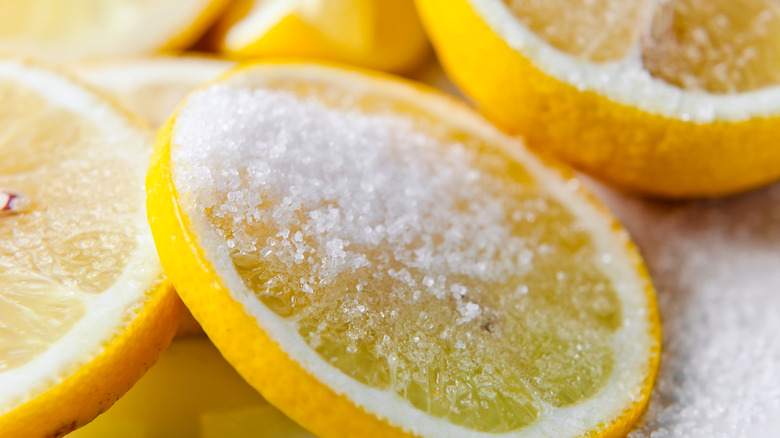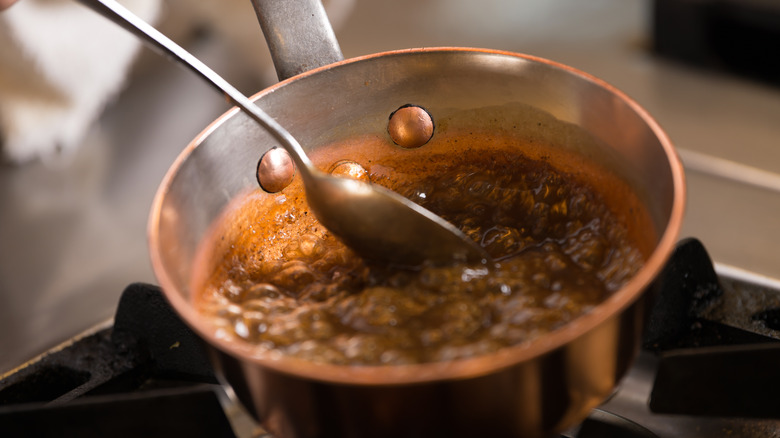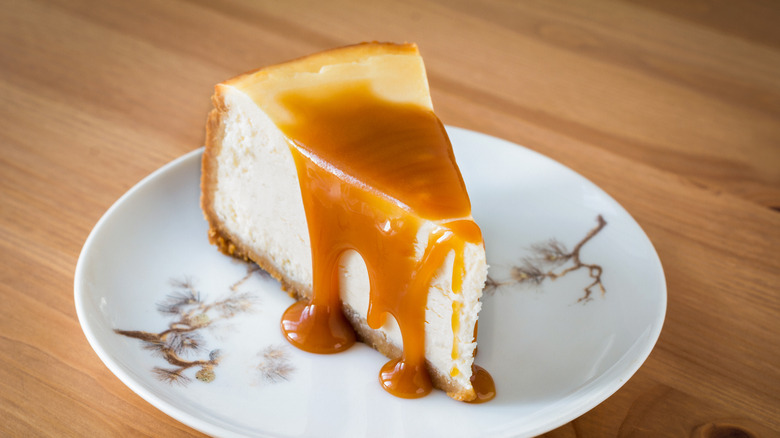The Lemon Hack To Prevent Sugar From Crystalizing
When you cook sugar to create homemade confections, it can quickly crystallize into hard chunks. Unless you're making rock candy, this phenomenon is nothing short of maddening. Homemade caramel is prone to this pitfall, but crystallization can also lead to grainy fudge and other textually-inconsistent treats. Luckily, the fix can be as simple as a squeeze of lemon juice, as chef Stephanie Boswell demonstrates in a video from Food Network.
Hot tip: Lemons are the key to saving your sugar from crystallizing!! 🍋 And with a little cream and butter you can turn it into caramel! (Thanks, @steph__boswell!) #FNHotList pic.twitter.com/viDFJzqFpK
— Food Network (@FoodNetwork) February 11, 2024
While cooking sugar to make caramel seems simple, the sucrose molecules in the sugar can stick to each other too much and re-form into hard, cloudy chunks. Using a pot or utensils that aren't pristinely clean can cause crystallization, as can excessive stirring. But sometimes, it happens just because melting sugar is a finicky process and moves faster than you can keep track of. Before you know it, your sugar has gone from smooth and glossy to overheated and hard.
As an acid, lemon juice can break sucrose down into glucose and fructose in a process called inversion. Since sucrose molecules really want to stick to each other, reducing their presence while allowing the less-sticky glucose and fructose to get in their way keeps them from bonding excessively. You only need to use a dash of lemon juice, unless you want a lemon-flavored caramel — you don't need a lot of it in order to enjoy its magical, texture-enhancing effects.
Other ways to keep sugar from crystalizing over heat
No lemons on hand? You can also use another acidic ingredient like cream of tartar to break down the sucrose molecules in your caramel, or add an invert sugar like corn syrup or honey. These liquid sugars are already "inverted," so they can keep your caramel smooth and ensure the granulated sugar won't turn gritty and hard.
If you're concerned about extra ingredients that could alter the caramel's flavor, try Carla Hall's caramel trick. She recommends placing a lid over your pot, which traps moisture and can keep the sugar from turning dry and hard. Be sure to use a glass lid so you can see inside the pot. After all, you wouldn't want to miss the color change that tells you your sugar is caramelized, and it's time to add butter and cream. We know the best way to clean a layer of burnt sugar fused to the bottom of your pan, but it's better to avoid it in the first place.
After your low-stress caramel is complete, you can mix it with optional flavorings and enjoy the super-smooth texture, with no grittiness or crunchy bits. Salt and vanilla are classic choices, but if you're feeling creative, add a dash of hot sauce to boost your caramel for some sweet heat.
Keep your caramel sauce smooth with these other tips
For cooks who feel true trepidation over caramel, a few more prep tips can help to keep things smooth. One trick is to pulse your granulated sugar in a food processor before melting it. This breaks down the sugar molecules and makes it more difficult for large crystals to form once you apply heat. The broken-down sugar will melt faster, though, so really keep an eye on it.
Another method is to add water to your granulated sugar (also known as the "wet" caramel method) and keeping the pot on low heat until the sugar has completely dissolved. If you notice crystals starting to form, remove the pot from its heat source immediately and mix in some water, cold butter, or corn syrup to smooth it out again.
During the caramel-making process, you should use a silicone spatula (which is the tool Giada De Laurentiis can't cook without) and "brush" the sugar mixture back and forth, as opposed to stirring in circles. As mentioned before, stirring caramel too much can encourage crystallization. Some of the liquid sugar can end up on the walls of the pot, where it turns hard and chunky, and that texture can spread to the rest of the pot. Work slowly and carefully, utilizing your texture-boosting tips of choice, and you'll become a caramel-making expert.



